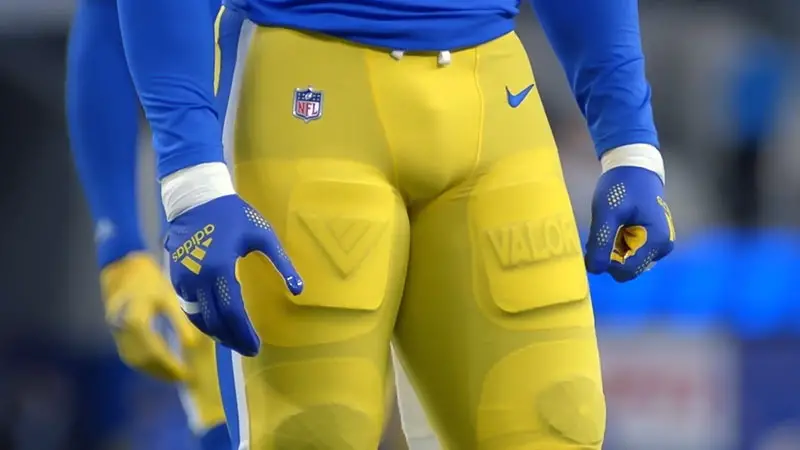Football is a game of speed, strategy, and sheer physicality, where every tackle and sprint can make or break a play. Amidst the intense action, protection becomes paramount, and that’s where football hip pads come into play.
These essential pieces of gear shield players from the impact of hits and falls, ensuring they stay on the field longer and safer.
Hip pads aren’t just about protection; they enhance performance by allowing athletes to move with confidence.
Whether it’s a high school player or a professional athlete, the right hip pads can mean the difference between a game-ending injury and a quick recovery.
Dive into the world of football hip pads and discover why they’re a must-have for anyone serious about the sport.
Overview of Football Hip Pads
Football hip pads are critical for player protection. These pads, typically made from high-density foam, absorb impacts, safeguarding hips and lower back areas.
Hip pads can be integrated into football pants or come as separate girdles, offering flexibility depending on player preferences.
Manufacturers design hip pads to be lightweight yet durable, combining materials like EVA foam and hard plastic.
This combination ensures pads provide sufficient cushioning while maintaining mobility. Many modern hip pads also feature moisture-wicking fabrics to keep players dry during games.
Football hip pads usually comprise three sections: hip, tailbone, and thigh pads. Each section specifically targets an area prone to injury. For instance, hip pads protect the iliac crest, while tailbone pads shield the sacrum.
Selecting the right size and fit is crucial. Ill-fitting pads can shift during play, leaving players vulnerable. Players should ensure hip pads snugly fit against their body without restricting movement.
Types of Football Hip Pads
Football hip pads come in various types, each catering to different player needs and preferences. Here’s a breakdown of the most common types.
Slotted Hip Pads
Slotted hip pads fit into pre-existing slots in football pants. These pads are secured by the slots, ensuring they stay in place during gameplay. Slotted pads usually feature lightweight materials like EVA foam for comfortable wear.
Snap-In Hip Pads
Snap-in hip pads use snaps to attach directly to football pants or girdles. These provide a secure fit and are easy to install and remove. Players often prefer snap-in pads for the convenience they offer during practice and games.
High-Rise Hip Pads
High-rise hip pads offer extended coverage for the lower back. These pads protect not only the hips but also the upper glutes and lower spine. High-rise pads are ideal for players looking for additional protection in high-contact positions.
Key Features to Consider
Football hip pads offer essential protection and performance benefits. When evaluating these pads, specific features impact their effectiveness.
Material and Durability
Football hip pads use materials like EVA foam, hard plastic, or a combination of both. EVA foam provides cushioning for impacts, while hard plastic offers added protection.
Durability is crucial: well-made pads withstand hits and last multiple seasons. Reliable brands frequently use reinforced stitching to ensure longevity.
Weight and Comfort
Weight directly affects comfort and mobility. Lightweight pads, especially those under 1 pound, minimize bulk while maximizing protection.
Comfort also depends on the pad’s design; breathable fabrics and ergonomic shapes enhance players’ ease of movement.
Girdles with integrated pads typically offer a snug, comfortable fit, reducing the likelihood of shifting during play.
Size and Fit
Size and fit are critical for optimal protection. Football hip pads come in various sizes, matching waist measurements to ensure proper coverage.
A correct fit prevents the pads from moving during intense actions, maintaining consistent protection. Adjustable straps or elastic waistbands can aid in achieving the best fit for different body types.
Technological Advancements
Football hip pads have seen significant improvements in recent years, thanks to technological advancements. Modern designs focus on enhancing protection, comfort, and performance.
Air Management Technology
Air management technology plays a crucial role in modern football hip pads. This technology uses small air pockets strategically placed within the pads.
These air pockets distribute impact forces across a larger area, reducing the risk of injury. Companies like Riddell and Schutt have incorporated this technology in their high-end models.
For instance, Riddell’s patented RipKord system offers quick-release air pockets, making it easier to remove pads after a game. This not only improves safety but also adds convenience for athletes and medical staff.
Impact Absorption
Impact absorption is vital for effective football hip pads. Advanced materials such as EVA foam, gel inserts, and high-impact plastics have been developed to absorb and dissipate force more efficiently.
Xenith’s hip pads feature a proprietary Aware-Flow shock absorber, which adjusts the level of impact absorption in real-time.
This innovation ensures consistent protection regardless of impact severity. Additionally, multi-layer designs are common, combining softer inner layers with harder outer shells to provide comprehensive protection without compromising mobility.
Lightweight vs Traditional Weight Pads
Here are the comparisons between lightweight and traditional weight pads:
Weight and Flexibility
Lightweight pads offer significant flexibility compared to traditional ones. Weighing around 1-2 lbs, these pads use advanced materials like EVA foam which provides excellent protection without bulk.
For example, Xenith’s hip pads focus on agility, making them ideal for speed positions. Traditional pads can weigh up to 3-4 lbs, constructed with denser materials, and offer more robust protection but at the cost of decreased maneuverability.
Protection Level
Lightweight pads deliver adequate protection with innovative materials like gel inserts and air management systems. Riddell’s Air Management technology in lightweight pads efficiently distributes impact forces.
In contrast, traditional weight pads use thick cushioning layers to absorb shocks, offering higher impact resistance but less comfort. This makes them suitable for linemen who face more direct contact.
Comfort and Fit
Advanced models of lightweight pads focus on ergonomic designs for better comfort. These pads include adjustable features for a customized fit. For instance, Schutt’s hip pads utilize breathable materials to reduce sweat buildup.
Traditional weight pads, although reliable in protection, often feature less ergonomic designs that can cause discomfort during prolonged use. Bulkier designs also make these pads harder to fit snugly.
Durability
Durability in lightweight pads has improved drastically, with high-quality materials enhancing longevity. Brands like Xenith incorporate materials that resist wear and tear, ensuring pads last through multiple seasons.
Traditional weight pads have a reputation for durability due to their sturdy construction. Thicker materials withstand repeated impacts, making them less prone to breaking down.
Price Considerations
Lightweight pads, using cutting-edge materials and technologies, often come at a higher price point. However, the investment can pay off for players prioritizing performance and agility.
Traditional pads might be cheaper initially, offering a cost-effective solution for players seeking durable and reliable protection without the need for advanced features.
Frequently Asked Questions
What are football hip pads made of?
Football hip pads are typically made from materials such as EVA foam, gel inserts, and high-impact plastic. These materials help absorb impacts and provide protection without sacrificing comfort or mobility.
How do hip pads improve performance in football?
Hip pads improve performance by absorbing impacts and reducing the risk of injuries. This allows players to maintain their focus on the game and perform at their best without the distraction of potential injuries.
What is the difference between lightweight and traditional football hip pads?
Lightweight hip pads offer greater agility and comfort but are often more expensive. Traditional hip pads, on the other hand, provide robust protection and durability at a lower cost. The choice depends on the player’s position and personal preference.
Are football hip pads mandatory in all leagues?
Yes, football hip pads are mandatory in most leagues, including high school, college, and professional levels. They are considered essential protective gear to ensure player safety on the field.
Can hip pads be adjusted for a better fit?
Many modern football hip pads come with adjustable straps or are designed to fit snugly within girdles. Proper fit is crucial for maximizing protection and comfort, allowing players to perform without restriction.
Conclusion
Football hip pads play a crucial role in protecting players from injuries and enhancing performance through impact absorption.
Proper fit ensures optimal protection and comfort. Various pad types cater to different needs and preferences. Advancements in technology have led to improvements in protection, comfort, and performance.
Comparing lightweight pads and traditional ones reveals distinct differences in weight, flexibility, protection levels, and cost. Lightweight pads, made with innovative materials, offer enhanced agility and comfort but are more expensive.
Traditional pads, on the other hand, provide durability and robust protection at a lower cost, fitting well with different player positions.
Football hip pads continue to evolve, offering players better performance through technological advancements. The choice between lightweight and traditional pads ultimately depends on individual needs and playing style.








Ashley Hopkinson